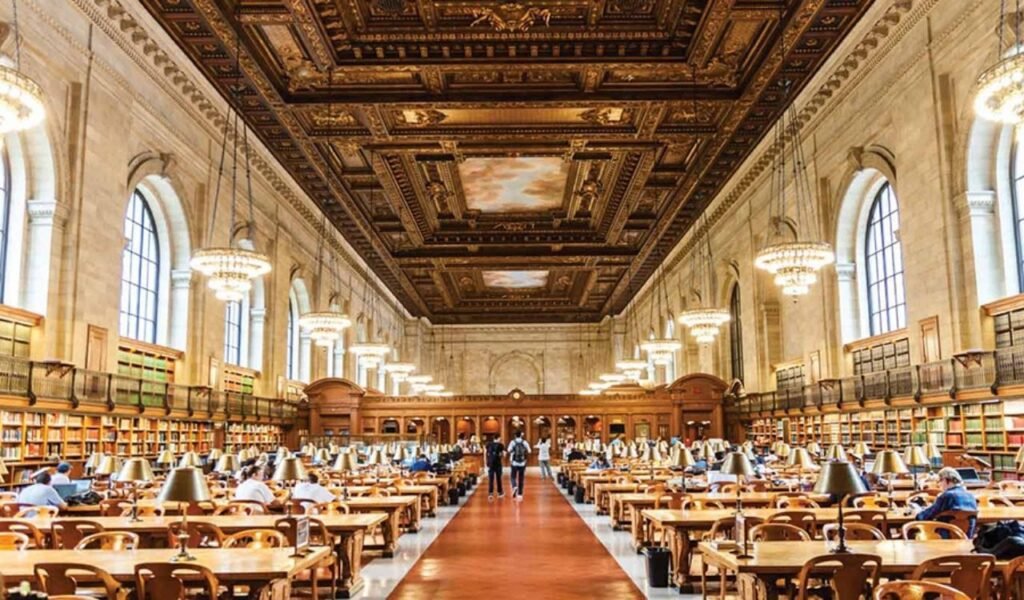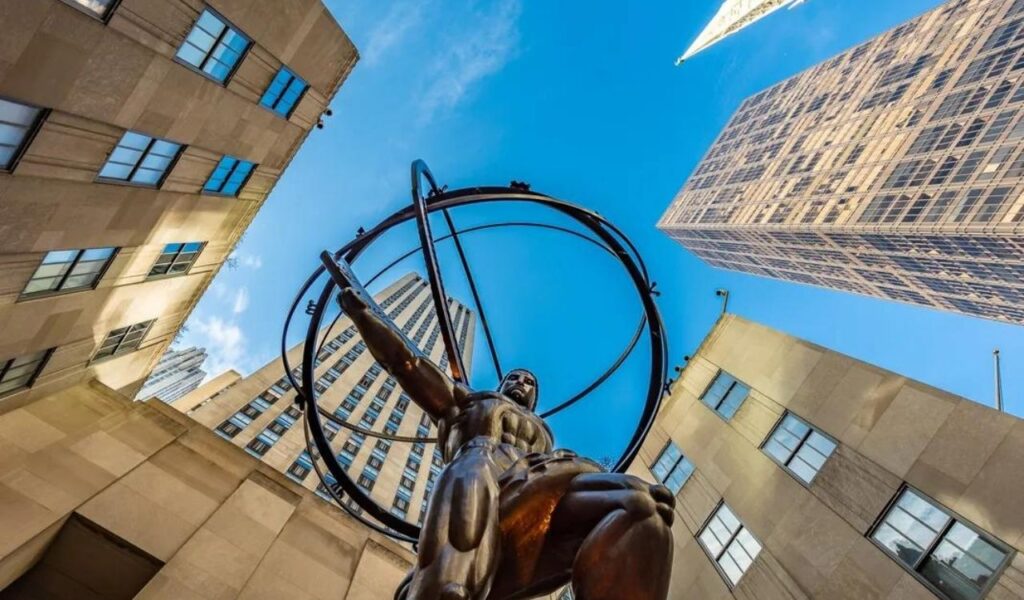“To be young and in love in New York City” – I like me better by Lauv was on every playlist a while ago and so is moving to New York, on every millennial and gen z vision board. Every one is infatuated with New York and for all good reasons. Moving to a New York City apartment is on many bucket lists, quite frankly including mine. New York City is famous for its beautiful skylines and glistening evenings. However, in this post, we will look at the New York City architecture, some of which is well-known throughout the world and some of which is hidden in plain sight.
New York City Architecture is as varied as the folks who reside there. Few cities are as at ease with architectural variation as New York, a metropolis that has always remade itself while never abandoning its history. As a result, it has one of the world’s most vibrant architectural mixtures, with several flagship specimens of their periods. New York City boasts one of the world’s biggest collections of structures, with a diverse variety of architectural styles spanning various historic and cultural periods.
Not just architecture with great historic significance, NYC houses some supremely aesthetic modernist buildings with brilliant interiors ranging from small cafes to public libraries, even a french bookshop has one of the prettiest ceiling murals in the city.
Table of Contents
Evolution of New York City Architecture
New York City has long welcomed people and ideas from all over the world, solidifying its status as a symbol of power, riches, and liberty. New York City architecture symbolizes the city’s transformation from a Danish fur-trading port to a worldwide destination where people from all over the world influenced — and shaped — the city.
New York’s architectural language has developed to reflect its evolving requirements and its reciprocal impact on the rest of the globe. From downtown to uptown, the city displays influences from close and distant.
1800-1900
Neoclassicism, which lasted from 1780 to 1820, was the first architectural style connected with New York City. Colonnades and arches are two of the most prevalent elements in Neoclassical architecture. The overall building design and space planning generally follow the traditional column pattern: a prominent base with a dramatic entrance, asymmetrical shaft with little ornamentation, and a pronounced summit.
The Gothic Revival style, which lasted from 1820 to 1860, is similar to the Greek Revival in that it has strong associational values, but instead of tying into politics, it contained religious and natural connotations. This elaborate space planning is famously linked with churches, but it was also employed for houses. It was created with the intention of instilling goodness in the wicked. St. Patrick’s Cathedral, Trinity Church, and Tavern on the Green are some of the most famous Gothic Revival architecture.

The Beaux-Arts Classicism trend continued to have an impact on New York City architecture in the early 1900s. From approximately 1890 to 1920, the Beaux-Arts style exaggerated classical references to genuinely super-grandiose dimensions, as seen in the Custom House at Bowling Green, Grand Central Terminal, and the New York Public Library.

1900 – 2000s
From landmark cultural centres to gleaming glass Modernist buildings, the twentieth and twenty-first centuries have seen a wide range of architectural styles. As the train moved underground, New York made greater use of the precious street-level space left behind, constructing trendy urban projects like Grand Central Terminal and The Barclay, which is now the InterContinental New York Barclay. Projects including Rockefeller Center, which houses the Radio City Music Hall, and Lincoln Center, which both aesthetically and culturally elevated the city, were part of this urban redevelopment.
Conversely, Frank Lloyd Wright’s Guggenheim Museum design, with its white, curving inverted ziggurat, enhanced New York City’s architecture vocabulary by producing a building that stood up while yet blending in with the physical landscape.
The early twentieth-century setback style evolved into Art-Deco, which returned to the use of decorative features found in previous architectural styles. However, in the latter part of the twentieth century, a shift to International Style emerged, which had a matchbox form and simple elements. Modern style architecture like Trump Tower, Madison Square Garden, and the World Trade Center Twin Towers are all examples of famous International Style structures that added to the New York Skyline.
During this time, several of New York’s most iconic buildings were erected. When it was finished in 1930, the location known as 40 Wall Street became the world’s tallest skyscraper, a distinction it only maintained for a few weeks. The Chrysler Structure, an Art Deco architectural landmark that reached 40 Wall Street the same year, was only then eclipsed by the Empire State Building, which had held the title of the tallest building in the world for over four decades.
In New York City Architecture, the high-rise tendency persists to this day. However, the city is not just growing; it is also redefining its urban landscapes with new icons such as the High Line. The architectural history of New York City is as diverse as the city’s inhabitants. The buildings’ varied designs and rich history were inspired by people from all over the world, and it is ingrained in the city’s fundamental composition.
The skyscraper, which first appeared at the turn of the twentieth century, changed the New York City skyline forever, simply taking it to new heights. New York, like the structures that make up this incredible city, persists to be a location where ideas become reality, are questioned, and reinvented.
Iconic Buildings in NYC
The stability and relevance that New York has offered over the city’s lengthy history distinguish it from all other metropolises. The Brooklyn Bridge, Lady Liberty, and One World Trade Center are just a few of New York’s iconic landmarks and structures. All of these structures are located in New York and have a long history. You might claim that New York is the birthplace of classic Americana fashion, and you would be correct. It’s home to a variety of new structures and modern style architecture, including the breathtaking Oculus, which has received a lot of publicity.
The significance of New York’s monumental architecture rests in the fact that it has been the source of inspiration for a wide range of projects. The architectural landscape of New York has had a significant impact on other cities; for example, Gurgaon has architectural characteristics that are similar to the New York City architecture and is one of the most identifiable aspects in the globe.
Globally Known Architecture of NYC
One Wall Street
Inside and out, Ralph Walker’s limestone-clad 1 Wall Street is a work of art. The Irving Trust Company originally inhabited the 50-story skyscraper, which was erected around the same time as the Empire State and Chrysler buildings. It has Art Deco setbacks and vertical patterns carved into the faceted exterior, but it’s the interior space planning that makes it truly unique.
Hildreth Meniere created a magnificent space in the building’s towering double-height lobby on Wall Street, which served as the bank’s first reception room. The Red Room is constructed out of a mosaic of red, gold, and orange tiles produced in Berlin. The Times describes the viewing area on the 49th level as “a gaspingly lofty chamber,” with arched ceilings covered with Philippine shells. Developer Harry Macklowe is currently converting the structure into a residence.
70s Pine Street
70 Pine, designed by Clinton & Russell, Holton & George in 1930 for CITGO, was formerly the world’s third-highest building. By today’s standards, it is still rather tall at 952 feet. According to Robins, the structure “rises in subtle setbacks like an ornate, elongated faceted diamond of Indiana limestone and white brick to a glass-enclosed solarium with a lighted lantern” that can be seen from up to 20 miles away.
The décor and space planning are also noteworthy, with “polychromatic marble, rippling marble walls, coffered plaster ceilings, and stunningly beautiful, abstract geometric Art Deco aluminum metalwork on anything from elevator doors to mailboxes” on display in the lobby spaces following the tower’s recent transformation to rentals.
Empire State Building
The Empire State Structure, which was the world’s tallest building when it was completed in 1931, sets the tone for the New York City skyline—but, as Robins points out, the building “has become such an icon beyond its architectural design that its style seems almost beyond the purpose.” The crucial word here is near, because the Shreve, Lamb, and Harmon design incorporate the geometric motifs that are so popular in Art Deco architecture. This is notably evident in the building’s window columns here framed in aluminum.
Chrysler Building
When it was opened in 1930, the Chrysler Building was the world’s tallest structure for a brief period of time, but it is now remembered for its beautiful Art Deco architecture. The Chrysler was designed by William Van Alen and is noted for its beautiful, sunburst-patterned crown, majestic eagles on the 61st storey, and radiator caps on the 31st floor, which pay respect to the business whose name graces the structure. It is the second building that holds great significance in the New York City Skyline.
Paramount Building
The heritage-listed Paramount Building, located at 1501 Broadway, was erected in 1927 as Paramount Pictures’ headquarter. The building features a stepped-back exterior in keeping with the era, with Art Deco details on its distinctive arched doorway. The Hard Rock Café now occupies a space in this building which plays an important role in New York City architecture.
30s Rockefeller Plaza

30 Rock, designed by Raymond Hood and a group of other notable architects of the period, became the focal point of the grandiose Rockefeller Center project. “The skin is simple, contemporary, and unfettered by the desire for stylishness—but stylish nonetheless,” according to the AIA Guide to New York. Perhaps New York City’s most enigmatic modern style architecture landmark. The building, which was once RCA’s headquarters, is currently owned by Comcast.
New York Public Library
The New York Public Library, also recognized as the Stephen A. Schwarzman Building and frequently referred to as the main branch of the library system, performs a better job than other world-famous libraries in inspiring and teaching curious minds. It is an essential source of study, a renowned New York City Architecture, and an outstanding Beaux-Arts gem, standing on Fifth Avenue between 40th and 42nd Street.

Many New York City architects, notably Carrere & Hastings, attended the Ecole des Beaux-Arts in Paris during the 1880s. The massive library building was also created in the manner of the Ecole des Beaux-Arts. In the early twentieth century, when the term “Beaux-Arts” was not as commonly used, this style was dubbed the “American Renaissance.”
It blends the ideas of classical Greek architecture and Roman Renaissance ideals. Symmetry, grandeur, ornate decoration, and visual hierarchy are characteristics of the style. Carrere & Hastings used complex decorative elements, lavishly adorned interiors, and magnificent stairways, among other things, to bring the Beaux-Arts style to life in their space planning.
Flatiron Building
In 1902, the Flatiron Building, a 22-story steel-framed structure, was finished. Its wedge form, designed by architect Daniel Burnham, fits well within the triangle plot in New York City Architecture that connects Broadway and Fifth Avenue. Whereas many buildings at the period had massive, reinforced bases, the Flatiron is constant from the bottom-up, rendering the architecture all the more attractive.
MET Museum
The Metropolitan Museum of Art, created by Richard Morris Hunt, a founding trustee, and architect, opened to the public in late 1902. The Beaux-Arts building on Fifth Avenue in Manhattan became the first public institution to purchase a painting by Henri Matisse in 1910. The two-million-square-foot structure now houses tens of thousands of artworks and artifacts and also hosts the ell-known Met Gala to raise funds.

Architecture Details in NYC that goes Unnoticed
New York City Architecture has several jewels concealed in plain view, despite its frantic pace, neon lights, enormous billboards, and soaring buildings. Let’s look at some of those details that will inspire architects for their next project.
Informal Walls in Formal Setting
In the 1970s, when the city was impoverished and crime was rampant, street art and graffiti became popular in New York City Architecture. Kids from the Bronx and Brooklyn who grew up in that atmosphere marked subway trains and buildings, despite the fact that it was reckless and wrong. Their new art genre eventually expanded throughout the world and into NYC museums and art galleries. Ironically, street art is a legitimized activity supported by business owners, community organizations, and even architects.
Graffiti walls have become a common sight in the streetscape of New York City and one can enjoy this art form almost anywhere in the city. Graffiti Wall of fame, 11th street, and first avenue are some of the many streets to find some spectacular art pieces in the city.
Cast Iron District

The Cast Iron District, which comprises 26 blocks and roughly 500 structures, is commonly known as the SoHo district of lower Manhattan. The neighborhood grew into a commercial centre in the nineteenth century, and the bulk of the structures were made of cast iron. Cast iron was found to be more cost-effective than granite and marble, and it could even be used to create decorative exterior components. It was also durable and generally fire-resistant, making it a popular choice in modern style architecture.
The neighbourhood had deteriorated by the early twentieth century, with the majority of its companies and rich folks have left. This was the time when a significant number of artists flocked to these vast loft spaces, which were very inexpensive for their homes. These artists were instrumental in preserving the neighborhood’s identity. The Landmarks Preservation Commission finally recognized the district, which is largely dominated by retail businesses, as a New York City Architecture landmark.
Brownstone Buildings

A trip around Manhattan’s Upper East Side reveals charming vistas of chocolate brown houses. The famous yellow taxis zipping around the city and Manhattan’s sky-high buildings are as distinctive to New York City Architecture as these brownstone residences. Brownstone originally appeared in the United States in the 1780s, at a period when Federal Style building was popular. Brownstone was used at the base and stoop of true Federal Style homes, just below the main door.
The most well-known Brownstone style in New York City, however, was erected in the late 1800s in the Italianate style. Brownstone is a kind of sandstone that darkens in colour when exposed to air. The bulk of New York City’s brownstone originated from Portland, Connecticut, making it both simple to ship and less expensive than limestone, marbles, and granite. Brooklyn Heights, Fort Greene, Park Slope, and Bedford Stuyvesant are just a few of the Brooklyn areas with a lot of brownstones. These brownstone townhouses are integral parts of some of Manhattan’s and Brooklyn’s most beautiful homes.
Fire Escapes

Because fire escapes are such an important element of New York City’s architecture, it’s difficult to overlook them. Around 1860, metal stairwells began to emerge on building facades as a legal requirement at a period when many structures were prone to deadly fires. Some buildings used pulley systems to allow occupants down in baskets before the enforcement of a real metal stair, and other structures utilized ropes to escape before the enforcement of an actual metal stair. The outdoor fire stair has to be built on the street-facing side of the building, with rigorous usage guidelines.
In quest of additional room, New Yorkers began repurposing the extra balcony space for a variety of uses. They are frequently glorified in films, although they are actually quite filthy rather than glamorous. These fire escapes are proven to be community builders for neighbourhoods in today’s environment, where city people are urged to stay indoors. During times of quarantine, many New Yorkers have transformed this little area into a mini paradise.
Juliet Balconies
Juliet balconies are generally long and narrow outdoor platforms accessible through glass doors or big windows. Juliet balconies are not huge protuberances by definition. They might barely be a few feet or even inches long. It’s sometimes possible to stand on them, and the larger can even accommodate a couple of outdoor chairs. The tiniest, on the other hand, can’t even accommodate a plant, let alone a human, and are only used to visually open up the space. For safety reasons, they are always bordered by railings or
a barrier. Also, for aesthetic reasons, the railings might be extremely ornate.

You are certain to notice unusual architectural elements in the New York City Architecture if it allows you to glance up from its typical turmoil without being rushed in your way. Juliet Balcony is one of these elements. A Juliet balcony is a very thin metal balcony installed outside French windows. The name derives from Shakespeare’s famous heroine Juliet. They were mostly included for aesthetics, but because they were just a few inches broad, they were essentially worthless. There have been numerous debates concerning the necessity of these balconies, however, when a Juliet balcony is present, the facades of certain buildings are embellished with an appeal.
New York City’s multi-faceted and dynamic personality would be incomplete without these architectural subtleties that adorn, enrich, and enhance it. New York City is not a city with a uniform architectural style, which is one of the qualities that makes it so spectacular. However, plenty of the city’s most recognizable structures have a common theme: Art Deco architecture, as seen in the Chrysler and Empire State Buildings, to list a few.
New York is the birthplace of concepts, architects, and accomplishments. All of these accomplishments have been achieved in the past, are being made now, and will continue being made in the future.










